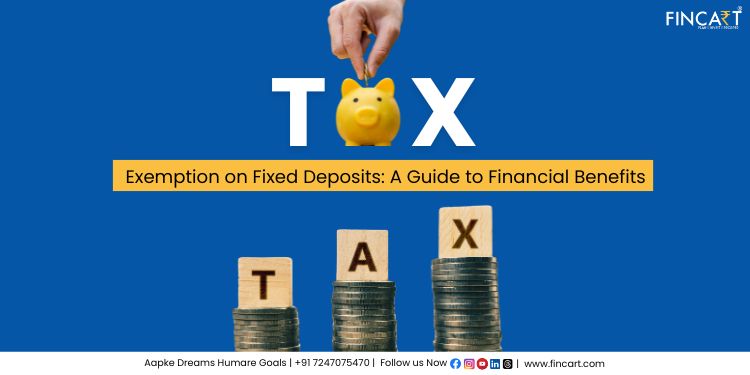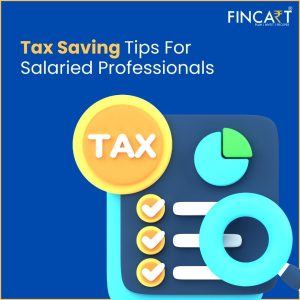Over the years, fixed deposits have remained one of investors’ top choices for generating a regular income stream. Offered by banks and non-banking financial corporations, fixed deposits offer near-guaranteed returns, making them an attractive option for conservative individuals looking for stability in their investments. There are two ways in which income earned from an FD is taxed. A tax on interest on fixed deposit investments earned in a year is charged as per the relevant slab rate applicable, and a TDS on fixed deposit investments is deducted by banks if the interest earned per year goes over a specified threshold.
Let’s check out the taxation rules for FDs by looking at provisions like 80C and 80TTB deductions, and Forms 15G and 15H to understand how one can save more tax on fixed deposit investments.
How Fixed Deposit Interest is Taxed
Of the five heads of income stated in the Income Tax Act, earnings from fixed deposits are reported under the head ‘income from other sources’ and taxed according to the individual’s tax slab. A TDS (Tax Deducted at Source) is also applicable in situations where the taxpayer’s FD interest income exceeds a certain limit.
1. Income from FD Interest and Taxation Rules
The tax on interest on fixed deposit investments is calculated at the end of the financial year, at the time of filing the income tax return. The total interest one earns in monthly or quarterly payments in the year is added and reported under the ‘income from other sources’ head and taxed as per the individual’s slab rate.
For example, if a non-senior citizen earns an interest of Rs. 30,000 from their fixed deposit, it is taxed fully as per their tax bracket unless their total income falls under the basic exemption limit.
2. TDS on FD Interest
Banks and NBFCs also deduct a certain percentage of interest payments and deposit it with the Income Tax Department on your behalf. This happens every time the payment is credited to your account, provided the total interest earned on fixed deposits exceeds the TDS threshold.
For individuals below 60, TDS is not deducted on interest less than Rs. 40,000. For senior citizens, the limit is a little higher at Rs. 50,000. This TDS on fixed deposit can be claimed as a tax credit while filing your income tax return. If your total taxable income is below the taxable limit, you can claim a refund for the TDS deducted by the bank.
As far as the rate is concerned, TDS is deducted at 10% if the interest earned exceeds the above limits. In case the taxpayer does not provide their PAN, the TDS rate rises to 20%. For example, if a non-senior citizen earns Rs. 60,000 interest from FD in a financial year, the bank will deduct a TDS of 10% (Rs. 6,000) before crediting the payments in their account.
3. TDS Deduction Threshold
- For taxpayers under 60 years of age: TDS is deducted only if the total fixed deposit interest income exceeds Rs. 40,000 in a financial year.
- For taxpayers above 60 years of age (Senior Citizens): The TDS threshold for senior citizens is comparatively higher, at Rs. 50,000. That means no TDS on FD interest is deducted if it is less than Rs. 50,000 in a given financial year.
These limits are set per fixed deposit. For example, if you have 2 fixed deposits with separate banks – One generating Rs. 70,000 per year and the other Rs. 30,000, then TDS will only be deducted from the FD generating Rs. 70,000, as it is over the Rs. 40,000 threshold for individuals below 60 years. The Rs. 30,000 FD interest from the other bank is under the TDS threshold, so no TDS will be deducted.
You will, however, need to report the total income earned (Rs. 1 lakh) when filing your ITR at the end of the financial year. This will be taxed as per your slab and your Rs. 7,000 TDS deducted from the first bank can be adjusted accordingly.
How to Save Tax on FD Interest
There are a few ways that can help you save TDS as well as tax on interest on fixed deposit investments. Remember, a tax consultant can help you make this process much smoother by ensuring you fully comply with the authorities while also saving you as much of your hard-earned money as possible.
1. Submit Form 15G or Form 15H
These two self-declaration forms are used to prevent TDS on fixed deposit interest if your total income is below the taxable limit. These forms state that the individual’s annual tax liability is zero because their annual income falls below the basic exemption limit.
- Form 15G is for individuals below 60 years whose total income is below Rs. 2.5 lakh (basic exemption under the old tax regime) or Rs. 3 lakh (basic exemption under the new tax regime).
- Form 15H is for senior citizens whose total income is below Rs. 3 lakh.
When the forms are submitted to the bank at the beginning of each financial year, they ensure that no TDS is deducted from the interest earned by your fixed deposits. If you hold FDs with multiple banks, the form needs to be submitted separately to each bank.
2. Tax-Saving Fixed Deposits Under Section 80C
Another way to reduce your tax liability is by opening a tax-saving fixed deposit. Under Section 80C of the Income Tax Act, one can claim a maximum deduction of up to Rs. 1.5 lakh in a financial year by investing in such FDs. The tenure for a tax-saving FD is 5 years, during which no withdrawals can be made. The interest earned on these FDs is also taxable and subject to TDS.
3. Senior Citizen Tax Benefits (Section 80TTB)
The government offers a significant benefit to senior citizens earning income through fixed deposits. According to Section 80TTB of the Income Tax Act, a deduction of up to Rs. 50,000 can be claimed by citizens above the age of 60 on FD and RD interest.
4. Other Tax-Saving Strategies
Here are some other strategies that can be used to minimise tax liability on fixed deposit interest.
- One can spread their investment across multiple FDs with different banks to ensure that the interest earned from each FD does not cross the TDS deduction threshold of Rs. 40,000 per financial year (or Rs. 50,000 for senior citizens). This strategy can help you avoid TDS deductions. For example, instead of making one FD which generates Rs. 80,000 (which will attract TDS), one may invest in 2 FDs generating Rs. 40,000 each and avoid TDS.
- One can also invest in multiple FDs under the name of different family members with a lower or no taxable income. Thus, the interest earned is either completely tax-free or taxed at a lower slab rate.
How TDS on FD is Calculated (With Examples)
Here are some examples to help you understand how TDS on FD interest is charged:
Case 1: If a non-senior citizen earns an annual FD interest of Rs. 80,000, a 10% TDS will be deducted by the bank before the payments are credited into the account. So Rs. 8,000 will be deposited with the Income Tax Department by the bank, which can be adjusted or claimed as tax refund at the time of ITR filing.
Case 2: If a senior citizen earns Rs. 50,000 FD interest in a financial year, no TDS on fixed deposit interest will be deducted as the total amount falls within the TDS threshold.
Case 3: If a non-senior citizen invests in 3 FDs, where the individual earns
- Rs. 50,000 from Bank A
- Rs. 35,000 from Bank B
- Rs. 75,000 from Bank C
Then, a TDS of 10% will be levied on interest earned from FDs in Bank A and C, since the income exceeds the TDS threshold for non-senior citizens. Bank B will not deduct any TDS on FD interest.
How to Claim Refund on Excess TDS
If you’ve paid more TDS than your tax liability, you can claim a refund at the time of filing your income tax return. The total TDS amount deposited with the IT Department will be subtracted from your total tax liability and the extra funds will be transferred to your preferred account in a few weeks.
People often make many mistakes when filing their ITR, which can cause penalties or delays when claiming refunds. Consider our expert-led tax consultation services for your needs to ensure a hassle-free tax filing process and more savings.
Fixed Deposits vs Other Tax-Saving Investments
| Investment | Tax Benefits | Lock-in Period | Returns |
| Tax-saving Fixed Deposits | Under Section 80C, up to Rs. 1.5 lakh can be deducted from one’s taxable income. The tax on FD interest is charged according to the account holder’s tax slab and may also attract a TDS if it exceeds a certain threshold. | 5 years. | Returns vary from 5.5% to 7.75% p.a. |
| Public Provident Fund (PPF) | Contributions made to fund, the interest earned, and the maturity amount are all exempt from tax. A maximum deduction of Rs. 1.5 lakh can be claimed under 80C. | Funds are locked in for 15 years, however, one can partially withdraw some funds under specific circumstances after holding the account for at least 6 years. | Announced every quarter. For Q4 FY 2024-25, the rate is 7.1% p.a. |
| National Pension Scheme (NPS) | NPS is also a Section 80C instrument, so it offers the same Rs. 1.5 lakh deduction benefit. However, Section 80CCD(1B) allows investors to claim an additional Rs. 50,000 deduction. | Until the investor reaches the age of retirement. Like the PPF, partial withdrawals are permitted for specific purposes after 3 years. | NPS returns depend on the asset allocation chosen by the investor. They are market-linked. |
| Unit Linked Insurance Plans (ULIPs) | A Section 80C instrument which offers the dual benefit of investment and insurance. A maximum of Rs. 1.5 lakh deduction can be claimed under 80C. According to Section 10(10D), the maturity amount is also tax-free given that the annual premiums don’t go over Rs. 2.5 lakh. | 5 years. | ULIPs also offer market-linked returns, however, policyholders can choose the type of fund they want to invest in according to their risk tolerance and financial goals. |
| Equity-Linked Savings Scheme (ELSS) | ELSS are also called tax-saving mutual funds due to the fact they offer Section 80C benefits. These equity funds have the shortest lock-in period among all 80C investments. The maturity amount attracts capital gains tax. | 3 years. | ELSS are mutual funds that invest mainly in equities, thus they are high-risk investments with market-linked returns. |
| Senior Citizens Savings Scheme (SCSS) | As the name suggests, this scheme is targeted at older citizens. It allows seniors to deduct a maximum of Rs. 1.5 lakh under 80C. Like FDs, interest earned is taxable. | 5 years. | For FY 2024-25, the interest rate for SCSS is 8.2% p.a. |
When to Choose FDs Over Other Investments
Saving tax on fixed deposit investments is attractive, but it’s also important to explore other options like PPF, ELSS, and ULIPs. One can consider investing in FDs when:
- The main goal is to preserve the value of capital.
- The investor wants to generate a steady stream of income, which is particularly important for retirees.
- One wants to maximise Section 80C benefits.
- One wishes to avoid market-related risks.
How to Plan FDs Smartly for Maximum Tax Benefits
1. Choose the Right FD Type and Tenure
Tax-saver fixed deposits have a lock-in period of 5 years, so investors should carefully consider whether they can commit to keeping their money locked in for the entire period before investing. If eligible, investors should also submit Form 15G or 15H with the bank to avoid TDS on fixed deposit interest.
2. Monitor Tax Regulations and Optimize Returns
While a fixed deposit is kind of a set-and-forget type of instrument, it’s still important to stay updated about the changes in rules that govern the tax on interest on fixed deposit investments. For example, the TDS threshold limit may change, and so may the TDS rate. Similarly, exemptions like Section 80TTB may be modified or similar provisions may be added for other citizens.
Conclusion
Interest earned from fixed deposits is fully taxable and is taxed as per the investor’s relevant slab rate. Banks also deduct 10% TDS on fixed deposit interest if the total interest earned exceeds Rs. 40,000 in a financial year (Rs. 50,000 for senior citizens). If PAN details are not provided, the TDS rate rises to 20%. Forms 15G and 15H can be used by individuals below 60 and senior citizens respectively to avoid TDS on FD if their total annual income falls below the basic exemption limit.




